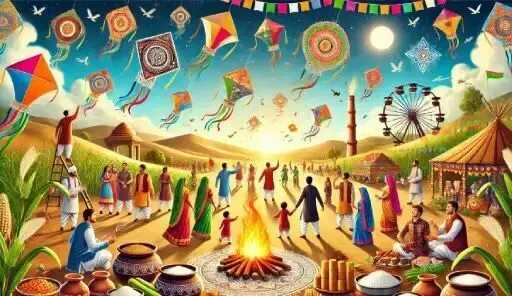From Pongal to Lohri: A Look at the Regional Celebrations of Sankranti
As the Sun starts its northward ascent, marking the conclusion of the winter solstice, India prepares to celebrate Makar Sankranti, a festival that symbolizes the harvest and the Sun's transition into Capricorn (Makar Rashi).
From Pongal to Lohri: A Look at the Regional Celebrations of Sankranti

As the Sun starts its northward ascent, marking the conclusion of the winter solstice, India prepares to celebrate Makar Sankranti, a festival that symbolizes the harvest and the Sun's transition into Capricorn (Makar Rashi). Although the core essence of the festival remains unchanged, it is observed under different names and customs across various regions of India, each with its unique cultural importance and rituals.
North India
In many parts of North India, the festival is called Makar Sankranti. It is celebrated with people taking sacred dips in rivers, particularly the Ganga, Yamuna, and Saraswati, to purify themselves of sins. Kite flying is a prominent tradition, especially in states like Uttar Pradesh and Rajasthan.
Tamil Nadu
In the southern part of India, particularly in Tamil Nadu, the festival is celebrated as Pongal, a four-day celebration honoring the Sun God. The first day is Bhogi, followed by Thai Pongal, Mattu Pongal, and Kaanum Pongal. During this time, families prepare a special dish called Pongal, made from freshly harvested rice, jaggery, and milk.
Punjab
Lohri, celebrated a day before Makar Sankranti, is an important festival in Punjab. It signifies the harvest of rabi crops and is marked by bonfires, traditional songs, and dances such as Bhangra and Gidda. People gather around the fire, offer sweets made from sesame seeds and jaggery, and pray for prosperity.
Assam
In Assam, the festival is celebrated as Magh Bihu or Bhogali Bihu, marking the end of the harvest season. The celebrations include feasts, traditional games, and bonfires known as Meji. This festival highlights the agricultural heritage of the Assamese people and their deep connection with nature.
Uttar Pradesh and Bihar
In states like Uttar Pradesh and Bihar, Makar Sankranti is also known as Khichdi. Devotees prepare and distribute Khichdi, a dish made from rice and lentils, to the less fortunate. Taking holy dips in rivers is a key part of the celebrations, symbolizing spiritual purification and renewal.
Kashmir
In Kashmir, the festival is known as Shishur Sankrant and signifies the end of the harsh winter season. The focus of the celebration is less on grand festivities and more on religious observance and family reunions.
West Bengal
In West Bengal, the festival is called Poush Sankranti, celebrating the new harvest with the preparation of traditional sweets made from rice and date palm jaggery, known as Pithe. The Ganga Sagar Mela, a major fair held at the confluence of the Ganga and the Bay of Bengal, attracts thousands of pilgrims.
Central India
In regions of Madhya Pradesh and Chhattisgarh, the festival is called Sukarat. It is celebrated with traditional folk songs, dances, and feasts, highlighting the joy of harvest and community unity.
Makar Sankranti, celebrated in its many forms and names, is a vibrant reflection of India's rich cultural diversity. It is a festival that brings the country together in appreciation of the harvest and the new beginnings that the Sun's journey signifies.

